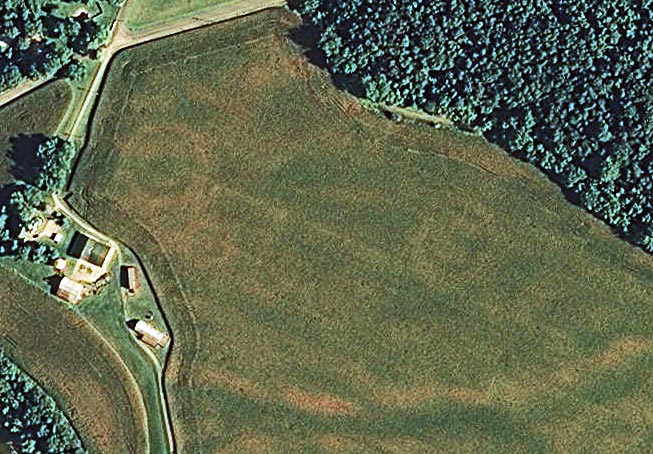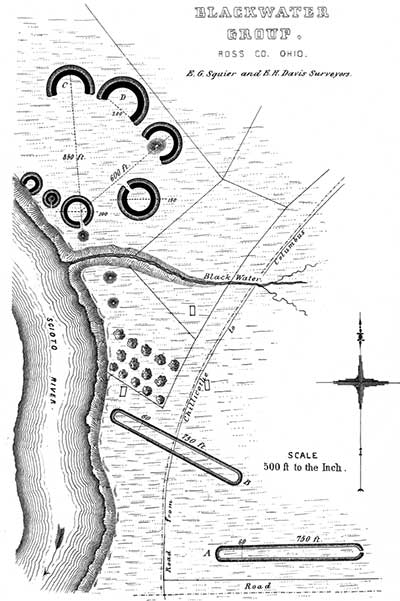PLATE XXII. No. 1.51
Junction Group, Ross County, Ohio.


[This site has effectively been destroyed; however, soil compaction from the earthworks, ground wetness, and vegetation growth sometimes reveals these ancient sites. Can you see the ghost images in this picture? GPS: 39.316445432, -83.014047146]
THE singular group of works here represented is situated on Paint creek, two miles south-west of the town of Chillicothe. It consists of four circles, three crescents, two square works, and four mounds. The eastern enclosure is the principal one; and, in common with all the rest, consists of a wall three feet high, with an interior ditch. It is two hundred and forty feet square, the angles much curved, giving it very nearly the form of a circle. The area, bounded by the ditch, is an accurate square of one hundred and sixty feet side, and is entered from the south by a gateway twenty-five feet wide. To the south-west of this work, and one hundred and thirty feet distant, is a small mound enclosed by a ditch and wall, with a gateway opening to it from the north. The ditch dips from the base of the mound, which is but three feet high by thirty feet base. Almost touching the circle enclosing the mound, is the horn of a crescent work, having a chord of one hundred and thirty-two feet. Sixty-six feet distant, in the same direction, is still another crescent, which terminates in a mound of sacrifice, seven feet high by forty-five feet base, which commands the entire group of works. This mound was carefully opened in October, 1845. The following passages, from the notes taken on the occasion, may not be out of place here. They will prove more intelligible to the reader, after an examination of the chapters on Mounds.
The mound is composed of clay. A simple shaft was sunk from the apex, five feet square. About three feet below the surface, upon the northern side of the excavation, was found a layer of wood coals, three or four inches in thickness, which extended within range of the excavation perhaps a foot, where it was broken up and intermixed with the clay composing the mound; some fragments were found within a few inches of the surface. From this fact it was inferred that the mound had been disturbed since its erection,—with what correctness will be seen in the sequel. In this layer of charcoal was found a human skeleton, much decayed, the skull and jaws crushed. Proceeding downwards, the earth below the unbroken charcoal was homogeneous, while towards the centre of the mound it was intermixed with detached coals. About seven feet beneath the surface of the mound, and probably a little below the surface of the adjacent plain, and in the centre of the excavation, were found three skeletons, in a very good state of preservation. The earth above them was mingled with coals, and also with fragments of hard-burned clay, which were immediately recognized as portions of the "altar" peculiar to a certain class of mounds devoted to religious purposes. It was clear that the mound had been opened, and its structure broken up, to afford the rite of sepulture to the skeletons here found; and it was concluded from this fact, as well as from their well-preserved condition, that the remains were those of the later Indians, who frequently buried in the mounds. The skeletons were placed side by side, with their heads towards the east. But one circumstance weighs against the above conclusion, and that is the depth at which the skeletons were deposited. The modern Indians bury in shallow graves.
Further examination disclosed the remains of the altar, about one third of which remained entire. Upon it were found a number of relics, clearly pertaining to the mound-builders.
The character of the remaining works is sufficiently apparent, without further explanation. That they were not designed for defence is obvious, and that they were devoted to religious rites is more than probable. They may have answered a double purpose, and may have been used for the celebration of games, of which we can have no definite conception. It has been suggested that the enclosure A as also B and C, were occupied by structures, temples perhaps, which in the lapse of time have disappeared. Similar groups are frequent,—indeed, small circles, resembling those here represented, constitute, in the Scioto valley, by far the most numerous class of remains. They seldom occur singly but generally in connection with several others of the same description, and accompanied by one or more mounds; sometimes they are connected with long parallel lines of embankments, of which more particular mention is elsewhere made.
 This group occupies a beautiful plain forming the third terrace, upon the edge
of which, at D, is a mound, formerly of considerable dimensions, but now much
reduced in altitude. Upon the opposite bank of the creek, and occupying the
corresponding terrace, are other works, consisting of a small circle and a number
of small mounds.
This group occupies a beautiful plain forming the third terrace, upon the edge
of which, at D, is a mound, formerly of considerable dimensions, but now much
reduced in altitude. Upon the opposite bank of the creek, and occupying the
corresponding terrace, are other works, consisting of a small circle and a number
of small mounds.
PLATE XXII. No. 2.
Blackwater Group, Ross County, Ohio.
THIS group, which very much resembles that last described, is situated on the right bank of the Scioto river, eight miles above Chillicothe, near the Columbus road. It is specially remarkable for its singular parallels, A and B of the. plan. Each of these is seven hundred and fifty feet long by sixty broad, measuring from centre to centre of the embankments. They are in cleared ground, which has been cultivated for more than twenty years; consequently the walls are much reduced, being now scarcely two feet in height. A gateway opens into the southern parallel, from the east. A corresponding opening may have existed in the other parallel, though it is impossible to discern it now. The ground embraced in the semicircular works C and D is reduced several feet below the level of the plain on which they are located. The mounds belonging to this group have never been investigated; hence their character is undetermined. The group is introduced in this connection, on account of its resemblance to the one just described. It is just to conclude that both were erected for a common or analogous purpose.
51. This group is indicated by G in the Map, Plate ll.

